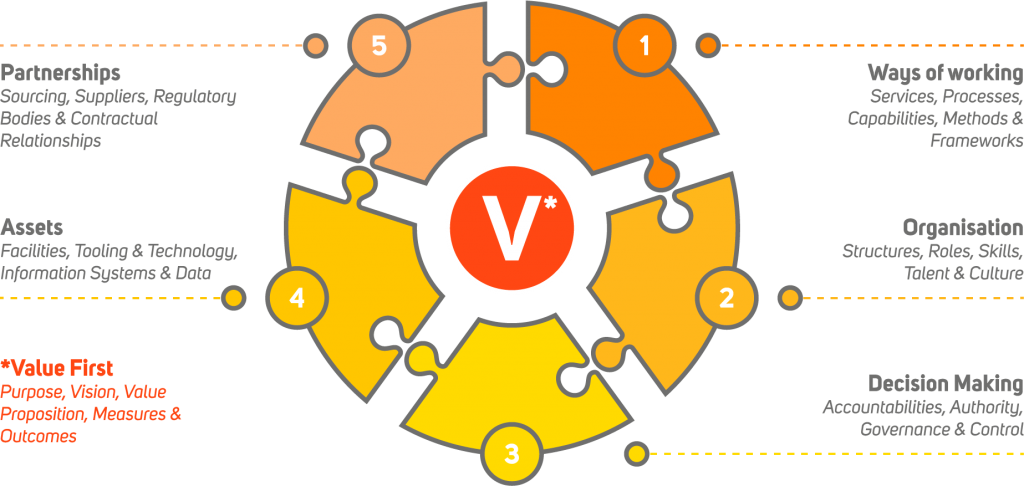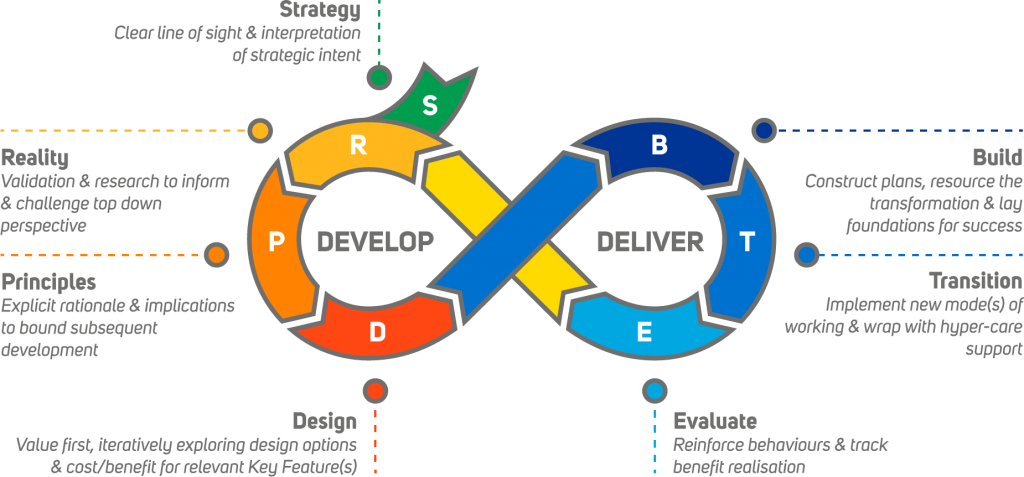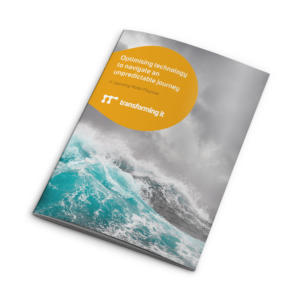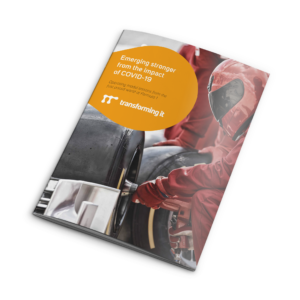Placing the value to be delivered as the central focus – the “why”, your programme of IT Operating Model transformation follows a defined flow through 6 dependent elements:

Success only comes when the model is put into practice, so underpinning each step of the transformation programme is the clarity of outcome that each decision taken and every new approach will result in. If you aren’t able or can’t operate with the implications of your design principles, you need to find other agreeable approaches.
When this comes into play as a transformation to be delivered, you can see how establishing the value to be achieved is the critical starting point and as progress is made, the impact of your underlying design principles are to be clarified and agreed upon.
How to orchestrate change: A model for sustained momentum
We developed this model as a best practice approach to successfully manage the change project. This not only underpins the engagement and commitment to the heavy lifting required to deliver an IT Operating Model transformation, but it also drives momentum into the utilization of the model, ensuring the maximum return for your organizational investment.

Long-term success: Continuing to build on the gains
Even before the 2020 Vendee Globe had finished, as their skippers raced across the oceans, teams we already utilizing the data gained from the race so far in conversations with shipyards to discuss planning for the 10th edition of the race in 2024.
“We already had requests for quotes before the finish and we feel that these are serious projects” – Yann Dollo, Deputy General Manager of the CDK shipyard.
For you and your business, this new understanding and focus on the importance of optimizing your IT Operating Model to achieve your big value goals can’t be a one-off project, it must be a new way of working.
To this end, this transformation needs a continued critical assessment of your operations, not only to ensure that the new ways of working are following the intended design, but also to take into account future technology and inevitable changes in both the internal and external environment.
As the sailors in the Vendee race must do, always keep focused on the measurements of success, upcoming patterns and be ready to adjust where needed.
Why approach the start line: Review the race you’ve run to see opportunity in change
Your organisation has been in it’s own race from the moment it was founded, with many successful and some not-so successful advances being made over time. To navigate the challenging and disruptive future you face, your next step is to critically evaluate how well your business is supported by your approach to IT.
Throughout the Vendee race, sailors know that even when there is huge pressure on them to perform every moment, it’s also essential to log the good, the bad and the ugly of what’s gone well or not, so they can be better prepared for the next time they race.
After the 2020 race, Giancarlo Pedote, Skipper PRYSMIAN GROUP, explained the reality of racing while planning for the next in 2024.
“You have to find a solution – at sea you can’t avoid things you don’t like. When you push your limits like this the sea gives you the opportunity to grow. On land we can get out of our difficulties easily – but then you learn nothing. When you choose difficulty you learn and you grow and renew – that’s what pleases me.”
Our role: Planning for the future, while achieving today.
This critical analysis of how effective your IT infrastructure has been at supporting your business as it has weathered storms and strived for goals, is what you need to do now.
Transforming IT’s role starts by facilitating your review, which is essential for your change journey. Every project we work on starts by helping our clients establish the gaps they are pushing against and the gains and huge leaps in improvement that could be achieved through an optimised IT Operating Model. That is the justification to invest in making changes.

